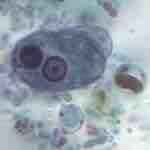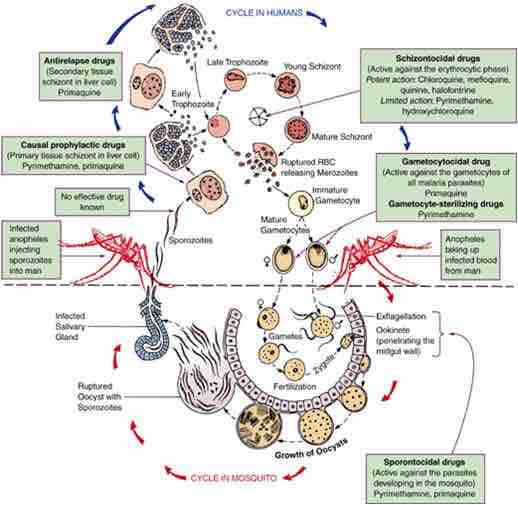Parasites are organisms that live on or in a host organism to obtain food. Two major classes of parasitic organisms include protozoa and helminths.
Protozoa are unicellular eukaryotic organisms that are classified as either free-living or parasitic organisms. Protozoa are further classified based on their mode of locomotion and include: Sarcodina (amoeba); Mastigophora (flagellates); Ciliophora (ciliates); and Sporozoa (non motile in adult form). Some examples of diseases caused by protozoa include: Malaria, Giardia, Trichomoniasis, and Leishmaniasis.

Entamoeba histolytica
Entamoeba histolytica is classified as a protozoa, specifically a Sarcodina.
Helminths are multicellular eukaryotic organisms that are also classified as either free-living or parasitic chemoheterotrophic organisms. Helminths are parasitic worms and are divided into three major groups including: flatworms (platyhelminths); thorny-headed worms (acanthocephalins); and roundworms (nematodes and hookworms).
Hookworms
Hookworms attached to the intestinal mucosa.
The variation that exists between protozoa contributes to complications associated with developing effective drugs. The lack of similarities between protozoans demands the need for highly specific drugs and medications against individual pathogens. In addition, protozoa are eukaryotic and exhibit similar properties and metabolic pathways as human cells. Therefore, the drugs that are developed to target protozoans are classified by either their mechanism of action or the organism for which they target. In terms of mechanism of actions, most antiprotozoan drugs specifically target the organism to prevent its growth and reproduction.
Protozoal diseases can also be prevented by targeting the route of transmission and/or targeting vector organisms. For example, Malaria is caused by the protozoan Plasmodia. This parasite is injected into humans via mosquitoes. The development of antimalarial drugs are based on the life cycle of Plasmodiain both the mosquito and human host .

Life Cycle of Plasmodium
Malaria, a protzoan based disease, is transmitted via an arthropod vector. The development of antimalarial drugs focuses on the life cycle in both the mosquito and human hosts.
Other types of antiprotozan drugs specifically target metabolic mechanisms utilized by the parasite. For example, African sleeping sickness is caused by trypanosomes. The drug Eflornithine attacks this parasite by targeting an enzyme responsible for regulating cell division.
Helminths are characterized as various types of parasitic worms, which are effectively targeted by promoting expulsion from the body. Parasitic helminths worms include: tapeworms, flukes, leeches and hookworms. The drugs utilized to target helminths are characterized based on chemical structure and mechanism of action. A few examples of the major drug classes include: piperazine, benzimidazole, levamisole, pyrantel, morantel and emodepside.